
|
July 24, 2020 sowing Set 3
Peniocereus greggii SNL1 (30) max germination count = 38 Count Sept 19 = 40 Astrophytum capricorne (100) max germination count = 77 Count Sept 19 = 65
Echinocereus triglochidiatus (150) max germination count = 84 Count Sept 19 = 94 Escobaria missouriensis SNL155 (150) max germination count = 100 Count Sept 19 = 87
Two weeks later. The plants are really small. They're only eight weeks old. They've got spines. They are identifiably cacti. Note again how similar the Echinocereus triglochidiatus and the Escobaria missouriensis appear. Note also how uniformly large (uniformly small?) the members of each of the four species are. Look especially at the Peniocereus greggii seedlings. The eventual size variation of all four species hasn't yet kicked in. Size at any point is a function of both genes and environment. Environment is typically food and water, but, for plants, it turns out root room is also extremely important. This principle is shown by all the bonsai plants in small pots. (I saw tens of thousands of bonsai all over China in my four trips there, including a supposedly thousand year old banyan tree about 8' tall in a 6'X6'ceramic pot. A banyan tree growing wild will be more than 50' tall and cover many acres(!), since the branches sent out roots and thereby grow to cover a lot of ground.) The key factor making those plants small is the pot size. There is no special skill required to make a bonsai plant. Small pots are all it takes. If you look for them, you can find lots of very old and very small cactus plants surviving in nature in some crack in a rock. The crack and rock are the bonsai pot.